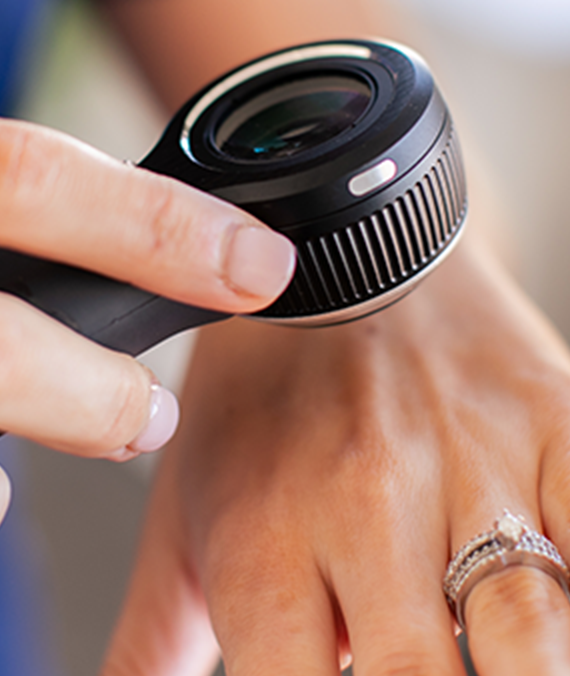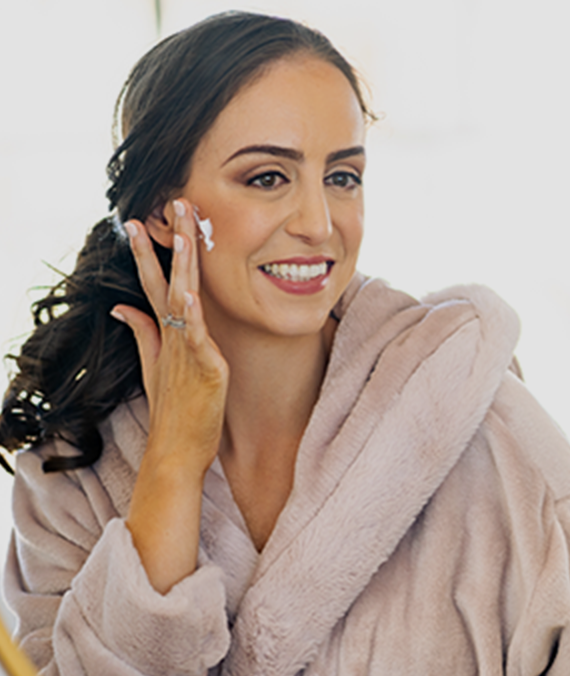Hello, my beauties! Today’s episode is dedicated to a super common skin condition – acne. For those of you who have it, know that you’re not alone AND that it can be treated. There are a number of things you can (and shouldn’t) do to alleviate your symptoms and ensure you’re well on your way to having that healthy, glowing skin. The first of which is: stop following ungrounded advice.
There’s so many out there, especially online (I’m watching you, TikTok) – while some might be helpful, there are certainly many others that harm more than help. That’s what we’re trying to prevent; after all, the more damage (e.g., hyperpigmentation, scarring, etc.) your skin incurs, the harder it becomes to treat your acne.
On that note, let’s take a brief refresher of the Top 5 acne Mistakes I discussed in episode 29:
- Not changing your pillowcase – this habit leads to unwanted breakout by allowing dirt and bacteria to build up and contaminate your face.
- Picking pimples – for the love of all things beautiful (like Your face), DO NOT pick pimples. Doing so could lead to infection, swelling, hyperpigmentation, and worst, scarring. As a Dermatologist, believe me, it takes more effort to treat acne scarring than to stop yourself from pimple picking.
- Using (physical) scrubs – this one’s even worse than picking pimples. These scrubs not only worsen inflammation but also cause scarring while spreading your acne bacteria all over your face, causing more pimples to pop up (yeah, it doesn’t get worse than that).
- Not moisturizing – my beauties, I won’t put “Moisturizer” in my Skin Success Framework if not everyone needs it. Before you say, “but moisturizers make oily, acne-prone face oilier” – that’s an S-class myth. Remember: your face can be oily while being dehydrated (a.k.a. more prone to pimples).
- Waiting too long to see a Dermatologist – ever heard of “if symptoms persist, consult your doctor” – well, you need to do just that for acne. As I mentioned, untreated acne symptoms can become VERY hard to treat. With that, it’s best to seek your Dermatologist’s informed decisions ASAP for your persistent acne. Trust me, it’s worth it.
4 Tips for Taking Care of Mild Acne
Before anything else, it’s important for you to recognize how mild acne looks. Mild acne may consist of a few black or white spots, accompanied by one kind of inflammatory papule or one pustule. As a comedonal condition, mild acne is characterized more by blackheads and whiteheads than the multiple inflammatory (and larger) pustules or lesions that a full-blown acne has. On top of that, mild acne often doesn’t affect the entire face – mostly staying in the forehead, cheeks, or chin area.
With that, mild acne is still very treatable and there is absolutely no shortage of treatments for it. However, I’d like to share with you treatment solutions which have been researched and have scientific evidence backing their efficacy. These treatments are very accessible as well, given that they’re over the counter. So, here are some of the things I recommend for patients who have mild acne:
1. Topical Adapalene
This is a topical type of retinoid which is lower in strength than most retinoids out there. In fact, adapalene is the only evidence-based retinoid that is available over the counter for acne treatment (awesome, right?). Did-you-know? It took 20 years of research and tests before the FDA approved adapalene for over-the-counter use. This speaks for its efficacy and safety for use.
If you’re curious, adapalene works by adjusting the speed of skin cell turnover to make sure your skin goes through the right process – preventing your pores from clogging and keeping acne from growing. With that, adapalene also helps with acne-associated hyperpigmentation.
Moreover, adapalene not only helps with whiteheads and blackheads, it’s also good for treating inflammatory lesions. Word of caution, however, since adapalene is a retinoid, you should start off with a pea-sized amount and gradually increase your usage as your tolerance allows. Apply adapalene to a clean face nightly or as much as your face can handle – I recommend starting with a schedule of every three nights then increase your frequency and usage from there.
2. Benzoyl Peroxide
Adapalene actually pairs well with benzoyl peroxide, which helps kill acne-causing bacteria, helps build bacterial resistance, removes excess oil and dead skin cells, and decreases inflammation. Typically, you want to use a benzoyl peroxide cleanser once daily. In addition to its antibacterial properties, benzoyl peroxide can also be used for spot treating – you can find it mixed in creams for spot treatment. Overall, benzoyl peroxide is an ingredient people with acne can largely benefit from.
A great spot treatment product – which contains 10% benzoyl peroxide – is the Neutrogena Rapid Clear Stubborn Acne Medicine Spot Treatment Gel. This acne spot gel is clinically proven to reduce the size and redness of stubborn acne in 2 hours! I also recommend you try out the La Roche-Posay Acne Spot Treatment (this one uses adapalene) and the Vichy Sulfur Spot Treatment (this uses 10% sulfur). These work fast and effectively against blemishes and stubborn spots as well, on top of being suited for sensitive skin.
3. Moisturizer
This is probably the most underutilized acne treatment product. Again, omitting moisturizers from your skincare routine – because of the myth that oily skin doesn’t need moisturizer – is one of my Top 5 acne Mistakes. It may seem like an Oxymoron BUT your skin can be both dry and oily. When you don’t moisturize, your skin becomes dehydrated. Skin dehydration triggers increased sebum production which makes your skin oilier and caters to acne better. Yikes!
So, please, protect your skin barrier and moisturize. Overall, moisturizers help alleviate acne symptoms as well as acne treatment side effects. Meaning: using only Topical adapalene or benzoyl peroxide – without moisturizer – results in more skin inflammation. How? Those two products have the tendency to break your skin barrier. Thus, using them without moisturizer only leads to worse acne symptoms and worse, you’re probably going to stop using your acne medication thinking they aren’t helping you.
Do you see it now, my beauty? However oily you think your face is, never stop moisturizing. Let me tell you, however, that not all moisturizers are made equal. When choosing a moisturizer, oil-free and fragrance-free types work best for those with acne. You could also use ones with niacinamide, vitamin B, and ceramides since these ingredients help soothe and repair the skin.
4. Sunscreen
There is not one skin condition where sunscreen isn’t helpful. Whether it’s cloudy, rainy, and especially when it’s sunny, never forget to apply sunscreen. In terms of acne, what sunscreen does is minimize the oxidative damage – which is actually part of acne’s formation and Pathogenesis. On top of that, sunscreen also helps alleviate the Hyperpigmentation or Post Inflammatory Erythema that people get from old acne lesions and scars.
If you’re acne-prone, I always recommend the mineral-based zinc oxide or titanium oxide sunscreen. As with moisturizers, it’s best to stick with fragrance-free sunscreen as well since you don’t want to further compromise your (already acne-compromised) skin barrier. These mineral-based and fragrance-free sunscreens help in reducing chances of irritation while protecting your skin and helping reduce the acne marks overall. I know it’s a lot to remember. Don’t worry, I have a free downloadable guide on curated product recommendations for all and any skin types at skinmusthaves.com!
These 4 treatment tips bring you away from acne-ridden skin and closer to that healthy, glowing skin that you desire. However, if symptoms persist…? That’s right, don’t delay your visit to your Dermatologist. Also remember: acne treatment takes time and consistency. Don’t mind the extra steps, what’s important is achieving your skin goals in the long run.
Do’s and Don’ts for Treating Painful Pimples
DO’s
DO use warm compress to help ease your pimple into popping. Soak a cotton ball or a makeup remover pad in warm water and gently place it on the painful pimple. What this does is it helps bring your pimple’s core to the surface.
DO use ice for reducing redness, inflammation, and pain. Doing so also decreases the pimple’s size and overall visibility.
DO use spot treatment products to help loosen the blockage within the pore. Spot treatments help with painful pimples by directly delivering anti-acne active ingredients onto the pimples – thereby giving them the care they need to heal. One spot treatment product that I really recommend is the Vichy Sulphur Spot Treatment product. La Roche-Posay and Neutrogena’s Spot Treatment products are excellent for treating acne as well.
Now, you want to use these products at night since they can be very drying. On top of that, they’re difficult to incorporate with your makeup and sunscreen during the day. At least at night, you can use them before bedtime and come morning, you can simply wash them off.
DO consider going makeup-free during the day to allow your skin to breathe. Yes, you can use a pimple patch to protect your pimples but going makeup-free really speeds up your skin’s healing process. When you do this, using an oil-free tinted mineral sunscreen helps too.
If you really need to use makeup, however, consider going for makeup that contains Salicylic Acid in them – they may not be your usual preferred ones, but they would help your skin a lot. Remember: allowing the skin to breathe is key. So, avoid heavy makeup AND whatever you put on your face, don’t forget to remove them before going to bed (even Sunscreen). Text the word “PODCAST” to 480-530-8187 if you forget to remove your makeup and need reminders from your #1 Skin Supporter.
DON’Ts
DON’T adapt the habit of constantly touching your face – aside from being a COVID-19 precaution, touching your face can also spread acne-causing bacteria further and irritate your already-inflamed skin more. I understand, it can be tempting, but I advise you to make an effort to keep your hands off of your beautiful face.
DON’T pop your pimples – we’ve been through this BUT I cannot emphasize this enough: popping pimples makes your acne breakout worse. You don’t want the hyperpigmentation and scarring that comes after it – I mean, why would you, when they’re grueling to treat?
DON’T use physical scrubs (a.k.a. don’t compromise your skin barrier further) – again, for treating acne, we’re all about being gentle to the skin.
DON’T try trendy Lemon peels or any of those trending “cure-all” for acne you see on TikTok. I don’t mean to bear down on all of those but as mentioned, most of them deal more harm than good to your skin. It’s better to get expert advice from your Dermatologist instead of worsening your dark spots and hyperpigmentation from using the wrong products.
These Do’s and Don’ts could save you a whole lot of money and most of all, time. They’re simple and straightforward – please, my beauty, follow them. I understand that having a breakout is stressful BUT longer treatment time is even more so. Also, if you have an important occasion coming up (like a wedding, for instance), you could actually visit your Dermatologist for an emergency Cortisone Shot and rid yourself of huge pimple bumps ASAP (around 24-48 hours).
Healthy Habits, Healthy Skin
Sometimes, even after following all helpful advice, you still can’t seem to get rid of your acne. Before this happens, I want you to assess yourself: are you drinking enough water? Are you getting enough sleep (sleeping deep enough or sleeping at the right time)? Are you eating a balanced diet? How much screen time do you have? How’s your overall stress levels?
Self-assessment is important because we are our habits and sometimes, breakouts can be your body’s cry for help. Taking inventory of your habits – and acting on them – is a holistic approach to improving your skin and overall health. Of course, I’ll always be here to help you achieve your skin and health goals – providing you all the information (and motivation) you need!
Want to get a done-for-you roadmap on the preparation, products, and practices for acne (yes, it exists!)? I’m now accepting waitlist applications for the first round of The Healthy Skin Blueprint!
Also, if you forget to apply your sunscreen in the morning, or totally forget to wash your face and apply retinol and night cream at night, text “PODCAST” to 480-530-8187 to get skincare routine reminders and healthy skin affirmations directly from me.
If you enjoyed this episode, be sure to let me know on Instagram! You can tag me, @drnikoleta, with a screenshot of the episode and your greatest takeaways. I’d also really appreciate it if you would subscribe and leave a five-star rating on Apple Podcasts — that helps us share the podcast with more people like you who are looking to achieve the skin of their dreams!
Until next time, Step Out with Confidence® and rid yourself of acne, prevent unwanted breakouts, and achieve that healthy, glowing skin you so desire!
Dr. Nikoleta






Stay in the know
Dropping in with weekly self-love affirmations, inspo, and skin secrets from Dr. Nikoleta created with YOU in mind.